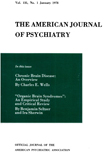RORSCHACH'S TEST AS A DIAGNOSTIC AID IN BRAIN INJURY
Abstract
The Rorschach test records of 60 post-traumatic, brain injured patients have been compared with those of 100 control patients in an effort to find factors characteristic of organic cerebral alterations. Piotrowski's ten signs of cerebral disturbance have been evaluated. The results indicate that impotence, perplexity, automatic phrases, repetition, and color naming are of value in identifying brain injured patients. Nine additional signs, which are found to be helpful in diagnosis, are named and discussed. A review of the test records from an interpretive viewpoint indicates that anxiety, depression and hypochondriasis were frequently present and schizophrenic-like disturbances were occasionally present among the brain injured patients.
Access content
To read the fulltext, please use one of the options below to sign in or purchase access.- Personal login
- Institutional Login
- Sign in via OpenAthens
- Register for access
-
Please login/register if you wish to pair your device and check access availability.
Not a subscriber?
PsychiatryOnline subscription options offer access to the DSM-5 library, books, journals, CME, and patient resources. This all-in-one virtual library provides psychiatrists and mental health professionals with key resources for diagnosis, treatment, research, and professional development.
Need more help? PsychiatryOnline Customer Service may be reached by emailing [email protected] or by calling 800-368-5777 (in the U.S.) or 703-907-7322 (outside the U.S.).



